Igneous rocks - Study guides, Revision notes & Summaries
Looking for the best study guides, study notes and summaries about Igneous rocks? On this page you'll find 744 study documents about Igneous rocks.
Page 3 out of 744 results
Sort by
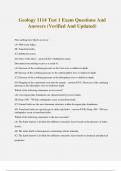
-
Geology 1114 Test 1 Exam Questions And Answers (Verified And Updated)
- Exam (elaborations) • 21 pages • 2024
-
- £10.20
- + learn more
Geology 1114 Test 1 Exam Questions And Answers (Verified And Updated) Flux melting most likely occurs at: (A) Mid-ocean ridges. (B) Transform faults. (C) Subduction zones. (D) None of the above - answer(C) Subduction zones. Decompression melting occurs as a result of: (A) Decrease of the confining pressure as the Core rises to shallower depth. (B) Increase of the confining pressure as the asthenosphere rises to shallower depth. (C) Decrease of the confining pressure as the lithosphere ...
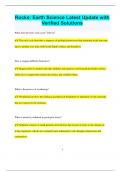
-
Rocks: Earth Science Latest Update with Verified Solutions
- Exam (elaborations) • 10 pages • 2024
- Available in package deal
-
- £8.15
- + learn more
Rocks: Earth Science Latest Update with Verified Solutions What does the term "rock cycle" refer to? The rock cycle describes a sequence of geological processes that transform rocks from one type to another over time, both on the Earth's surface and beneath it. How is magma different from lava? Magma refers to molten rock that solidifies into igneous rock beneath the Earth's surface, while lava is magma that reaches the surface and solidifies there. What is the process of w...
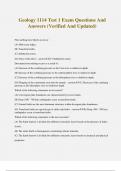
-
Geology 1114 Test 1 Exam Questions And Answers (Verified And Updated)
- Exam (elaborations) • 21 pages • 2024
-
- £10.20
- + learn more
Geology 1114 Test 1 Exam Questions And Answers (Verified And Updated) Flux melting most likely occurs at: (A) Mid-ocean ridges. (B) Transform faults. (C) Subduction zones. (D) None of the above - answer(C) Subduction zones. Decompression melting occurs as a result of: (A) Decrease of the confining pressure as the Core rises to shallower depth. (B) Increase of the confining pressure as the asthenosphere rises to shallower depth. (C) Decrease of the confining pressure as the lithosphere ...
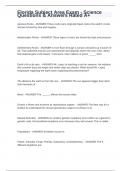
-
Florida Subject Area Exam - Science Questions & Answers Rated A+
- Exam (elaborations) • 17 pages • 2024
- Available in package deal
-
- £8.89
- + learn more
Igneous Rocks - ANSWER-These rocks were originally liquid, below the earth's crusts and are formed by lava and magma. Metamorphic Rocks - ANSWER-These types of rocks are formed by heat and pressure. Sedimentary Rocks - ANSWER-A river flows through a canyon and picks up a bunch of silt. That sediment and silt runs downstream and deposits where the river ends. When that material gets to the beach, it sits there. Over millions of years, _____ form. Earth's tilt on its axis. - ANSWER-Mr. ...
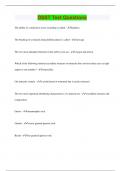
-
DSST Test Questions
- Exam (elaborations) • 13 pages • 2024
- Available in package deal
-
- £8.15
- + learn more
DSST Test Questions The ability of a mineral to resist scratching is called - hardness The breaking of a mineral along definite planes is called - cleavage The two most abundant elements in the earth's crust are - oxygen and silicon Which of the following internal crystalline structure of minerals does not have three axes at right angles to one another? - monoclinic Ore minerals contain - a useful metal or nonmetal that is easily extracted The two most important identifying c...
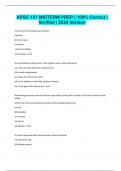
-
APSC 151 MIDTERM PREP | 100% Correct | Verified | 2024 Version
- Exam (elaborations) • 15 pages • 2024
- Available in package deal
-
- £10.20
- + learn more
The process of unloading can produce: (a) joints (b) mud cracks (c) pillows (d) cross-bedding (e) leaching - a An unconformity, like the one in the Kingston area, is best defined as: (a) a layer of rocks with very unusual fossils (b) a basal conglomerate (c) a layer of sedimentary rocks (d) a thin, tabular or sheet-like, igneous intrusion (e) a time gap in the rock record - e Weathering produces minerals that are more stable at the Earth's surface. Of the five minerals listed below...

-
APSC 151 MIDTERM EXAM QUESTIONS AND ANSWERS 100% CORRECT
- Exam (elaborations) • 10 pages • 2024
- Available in package deal
-
- £9.79
- + learn more
APSC 151 MIDTERM EXAM QUESTIONS AND ANSWERS 100% CORRECTAPSC 151 MIDTERM EXAM QUESTIONS AND ANSWERS 100% CORRECTAPSC 151 MIDTERM EXAM QUESTIONS AND ANSWERS 100% CORRECTAPSC 151 MIDTERM EXAM QUESTIONS AND ANSWERS 100% CORRECTThe process of unloading can produce: (a) joints (b) mud cracks (c) pillows (d) cross-bedding (e) leaching - ANSWER-a An unconformity, like the one in the Kingston area, is best defined as: (a) a layer of rocks with very unusual fossils (b) a basal conglomerate...
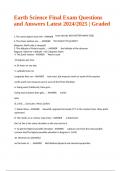
-
Earth Science Final Exam Questions and Answers Latest 2024/2025 | Graded
- Exam (elaborations) • 20 pages • 2024
-
- £11.42
- + learn more
Earth Science Final Exam Questions and Answers Latest 2024/2025 | Graded. The same objects have the - ANSWER same density (NO MATTER WHAT SIZE) 2. The closer isolines are... - ANSWER the steeper the gradient (diagram: North side is steepest) 3. The altitude of Polaris equals... - ANSWER the latitude of the observer Diagram: Observer's altitude = 66.5 degrees North 4. The Earth rotates - ANSWER West to east 15 degrees per hour in 24 hours or one day 5. Latitude lines run Longitude lines...
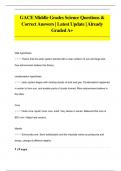
-
GACE Middle Grades Science Questions & Correct Answers | Latest Update |Already Graded A+
- Exam (elaborations) • 61 pages • 2024
- Available in package deal
-
- £11.83
- + learn more
tidal hypothesis : Theory that the solar system started with a near collision of sun and large star. Few astronomers believe this theory. condensation hypothesis : solar system began with rotating clouds of dust and gas. Condensation happened in center to form sun, and smaller parts of clouds formed. More astronomers believe in this idea. Core : Outer core- liquid; inner core- solid. Very dense in center. Believed that core is 80% iron. Helps heat oceans. Mantle : Surrounds core. ...

-
GLG 101 Final Actual Exam Questions and CORRECT Answers
- Exam (elaborations) • 12 pages • 2024
- Available in package deal
-
- £7.75
- + learn more
GLG 101 Final Actual Exam Questions and CORRECT Answers Rock Cycle - CORRECT ANSWER- Magma cools and solidifies creating igneous rocks. Igneous rocks are exposed at the surface and eroded away creating sedimentary rocks. Sedimentary rock deform under heat and pressure to form Metamorphic rocks. How we determine the relative ages of rocks - CORRECT ANSWER- We place rocks in their proper sequence of formation. Which rock formed first,second, third, and so on. Rock Types - CORRECT ANSWER...

Did you know that on average a seller on Stuvia earns £76 per month selling revision notes? Hmm, hint, hint. Discover all about earning on Stuvia


